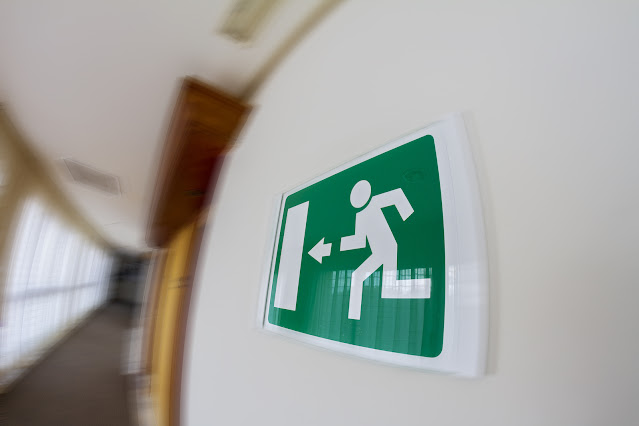How to Perform a Comprehensive Workplace Safety Audit: Key Areas to Focus On
First, the Backstory
As a safety and compliance professional in Southern Ontario, I have witnessed firsthand the importance of conducting regular workplace safety audits. Not only do these audits help to ensure the safety and well-being of employees, but they also play a crucial role in maintaining a positive and productive work environment. However, performing a comprehensive safety audit can be a daunting task, especially for those who are new to the process.
That's why in this article, I will be sharing my expertise and insights on how to perform a thorough workplace safety audit. I will guide you through the key areas that should be focused on during an audit, including physical hazards, training and emergency preparedness, and safety policies and procedures.
By the end of this article, you will have a better understanding of the importance of workplace safety audits and the steps you can take to ensure that your organization is meeting all necessary safety standards.
Let's dive in and learn how to effectively conduct a comprehensive workplace safety audit.
Start with safety audit checklist.
To ensure a comprehensive workplace safety audit, it is crucial to start with a safety audit checklist. This checklist serves as a guide for identifying potential hazards and assessing the overall safety of the workplace.Begin by reviewing and familiarizing yourself with relevant health and safety regulations and guidelines.
This will provide a framework for evaluating different aspects of the workplace, such as the physical environment, equipment, and employee practices. The safety audit checklist should include items such as emergency exits, fire prevention measures, proper storage and handling of hazardous materials, maintenance of safety equipment, and employee training programs. By systematically going through each item on the checklist, you can identify areas that require improvement and develop an action plan to address any safety deficiencies.
Analyze potential hazards and risks.
During the safety audit, it is important to analyze potential hazards and risks present in the workplace. This involves conducting a thorough examination of the physical environment, equipment, and employee practices to identify any potential sources of danger. Look for things like faulty wiring, slippery floors, inadequate lighting, or improperly maintained machinery. Additionally, assess employee behaviours and practices to identify any unsafe habits or lack of adherence to safety protocols.By analyzing potential hazards and risks, you can pinpoint areas of concern and take appropriate measures to mitigate them. This may involve implementing safety procedures, providing additional training, or making necessary repairs or upgrades to equipment and infrastructure. Remember, the goal of a workplace safety audit is to ensure the well-being of all employees and create a safe working environment.
Evaluate emergency evacuation procedures.
To evaluate emergency evacuation procedures as part of a comprehensive workplace safety audit, begin by familiarizing yourself with the existing emergency evacuation plan. Review the documentation provided, such as evacuation maps, procedures, and designated assembly points. Pay close attention to specific instructions for different types of emergencies, such as fires, natural disasters, or medical incidents.Assess the clarity and effectiveness of the instructions given, ensuring they are easily understandable and accessible to all employees. Additionally, evaluate the availability and functionality of emergency exit routes, including exit signs, stairwells, and emergency lighting. Check for any obstructions or potential hazards that may impede a swift and safe evacuation. Finally, simulate a mock evacuation drill to assess the efficiency and effectiveness of the procedures in place.
Observe how employees respond to the drill and identify any gaps or areas for improvement in their knowledge or execution of the evacuation plan. By evaluating emergency evacuation procedures, you can identify any deficiencies and make necessary adjustments to ensure the safety and well-being of all employees in the event of an emergency.
Assess employee training and knowledge.
To assess employee training and knowledge during a workplace safety audit, start by reviewing the training programs and materials provided by the company. Look for comprehensive training modules that cover essential topics such as emergency procedures, hazard recognition, and personal protective equipment. Evaluate the accessibility and effectiveness of these training resources, ensuring they are easily accessible to all employees and presented in a clear and engaging manner. Next, conduct interviews or surveys with employees to gauge their understanding and awareness of your workplace safety protocols. Ask about their familiarity with emergency procedures, their ability to identify potential hazards, and their knowledge of proper safety equipment usage. This will help identify any gaps in knowledge or areas where additional training may be necessary. Observing employees in their work environment can also provide valuable insights into their adherence to safety protocols. Take note of their adherence to safety guidelines, proper use of personal protective equipment, and their ability to recognize and address potential hazards. This can be done through regular workplace observations or by conducting safety drills to assess employees' practical application of safety procedures. It is important to document your findings and communicate them to the relevant stakeholders. Use the information gathered during the assessment to develop targeted training programs or initiatives aimed at addressing any gaps in employee knowledge or compliance with safety regulations. Regularly evaluating and updating training programs will help ensure a safe and informed workforce, ultimately contributing to a more secure and productive work environment.Conduct regular workplace safety audits.
Take a walk through the workplace and pay close attention to how employees are implementing safety measures. Observe if they are wearing proper protective gear, following established procedures, and maintaining a clean and organized work area. Look for any potential hazards or unsafe practices that may have been overlooked. Another important aspect of a workplace safety audit is to review incident and injury records. Analyze these records to identify any patterns or trends that indicate areas of concern. This can help pinpoint specific hazards that need to be addressed and provide insights into the effectiveness of current safety measures. Additionally, inspect the physical environment for potential hazards. Check for any damaged equipment, faulty machinery, or unsafe conditions such as slippery floors or inadequate lighting. Document any findings and prioritize them based on their level of risk and potential impact on employee safety. Lastly, it is crucial to involve employees in the safety audit process. Encourage them to report any safety concerns or suggestions for improvement. Their input can provide valuable information and help foster a culture of safety within the organization.By conducting regular workplace safety audits, organizations can identify and address potential hazards, improve safety protocols, and create a safer work environment for their employees. Prioritizing the health and safety of the workforce not only protects employees from harm but also contributes to increased productivity and overall success of the organization. Overall, conducting a comprehensive workplace safety audit may seem like a daunting task, but it is an essential step in ensuring the safety and well-being of employees. By focusing on key areas such as equipment and machinery, emergency procedures, and employee training, I can confidently say that I have created a safer and healthier work environment for myself and my colleagues.
Remember to regularly review and update your safety measures to stay ahead of potential hazards. With a proactive and diligent approach, we can all contribute to a safe and productive workplace.
Safety Audit FAQ
What are the key areas that should be included in a comprehensive workplace safety audit?
In my opinion, a comprehensive workplace safety audit should include key areas such as hazard identification and assessment, safety policies and procedures, employee training and education, safety equipment and tools, emergency preparedness plans, and incident reporting and investigation. These areas are essential for ensuring a safe and healthy work environment.
By conducting a thorough audit, we can identify potential hazards, evaluate the effectiveness of safety measures, and implement necessary improvements to prevent accidents and promote the well-being of all employees. It is crucial to prioritize workplace safety and constantly review and update these areas to maintain a safe working environment for everyone.
How can employers ensure that they are conducting a thorough evaluation of their workplace safety practices?
As an employer, I believe that ensuring a thorough evaluation of workplace safety practices requires a proactive approach. First and foremost, regular safety audits should be conducted to identify potential hazards and areas for improvement. Additionally, providing comprehensive training programs for employees is crucial to ensure they are equipped with the knowledge and skills to maintain a safe working environment.
Regular communication and feedback sessions with employees can also help identify any concerns or suggestions for enhancing safety practices. Finally, fostering a culture of safety where employees feel comfortable reporting incidents or near misses is essential. By consistently implementing these measures, employers can ensure a thorough evaluation of workplace safety practices.
What specific steps should be taken to assess the effectiveness of safety training programs during a workplace safety audit?
In my opinion, there are several specific steps that should be taken to assess the effectiveness of safety training programs during a workplace safety audit. Firstly, I would review the syllabus and curriculum of the training programs to ensure they cover all relevant safety topics. Next, I would observe the training sessions to assess the delivery methods and engagement level of the participants.Additionally, I would conduct interviews or surveys with employees to gather their feedback on the training effectiveness and their understanding of safety procedures. Lastly, I would analyze incident reports and accident data to determine if there has been a decrease in workplace incidents since the implementation of the training programs.
How can employers identify and address potential hazards or risks in the workplace during a safety audit?
As an employer, I can identify and address potential hazards or risks in the workplace during a safety audit by conducting a thorough inspection of the premises. I will closely examine the physical environment, equipment, and processes to identify any potential dangers. Additionally, I will review safety protocols, employee training records, and incident reports to assess any recurring issues.To address these hazards or risks, I will prioritize implementing preventive measures such as improving signage, providing proper personal protective equipment, and enhancing training programs. Regular communication with employees will also be key in identifying and addressing any concerns they may have.
What are some common pitfalls or mistakes to avoid when conducting a workplace safety audit?
When conducting a workplace safety audit, there are a few common pitfalls or mistakes that should be avoided. Firstly, it is important to not overlook any potential hazards or safety issues, as even small oversights can have serious consequences. Secondly, rushing through the audit without thorough documentation can lead to incomplete or inaccurate findings.Additionally, failing to involve employees in the audit process and not seeking their input can result in important insights being missed. Lastly, it is crucial to not neglect follow-up actions after the audit is complete, as this can undermine the effectiveness of the entire process. Overall, being meticulous, involving employees, and following through are key to conducting a successful workplace safety audit.
Contact Alternative Safety Solutions
- Alternative Safety Solutions
- 22 Augusta Street, Scotland, ON N0E 1R0
- 1-519-717-4601
- https://alternativesafetysolutions.ca/safety-on-demand/




Comments
Post a Comment